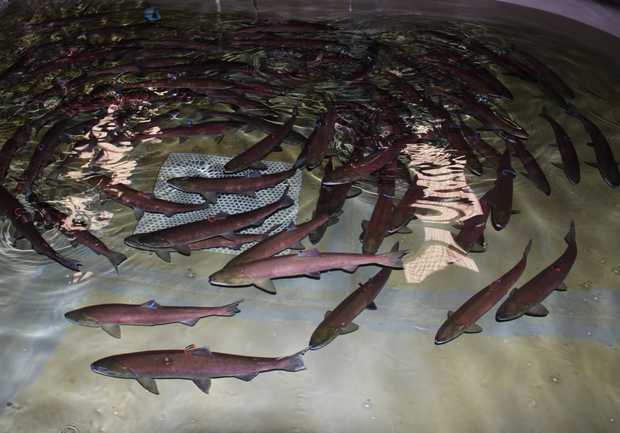forum
library
tutorial
contact

Snake Sockeye Set New Record
by Bill RudolphNW Fishletter, October 2, 2014
|
the film forum library tutorial contact |

|
Snake Sockeye Set New Recordby Bill RudolphNW Fishletter, October 2, 2014 |
 By Sept. 25, 1,443 sockeye had returned to the fish trap at Idaho's Redfish Lake and another 34 to Sawtooth Hatchery, which cracked the recent record of 1,100 set in 2011, and a huge improvement over the past two years, when returns never quite reached 300 fish. But that is a far cry from 2007, when only 4 sockeye returned. A year later, 650 showed up, and returns have never been below three digits since.
By Sept. 25, 1,443 sockeye had returned to the fish trap at Idaho's Redfish Lake and another 34 to Sawtooth Hatchery, which cracked the recent record of 1,100 set in 2011, and a huge improvement over the past two years, when returns never quite reached 300 fish. But that is a far cry from 2007, when only 4 sockeye returned. A year later, 650 showed up, and returns have never been below three digits since.
The new record means that more than 50 percent of the sockeye counted at Lower Granite Dam survived the last 450 miles to the Stanley Basin, and a resounding success for the captive broodstock program which brought the stock back from near extinction in the early 1990s. A proposed sockeye recovery plan released last June notes that it is moving into a new phase--reintroduction of natural populations into several lakes, with an interim goal of a 10-year geomean of 1,000 natural spawners in Redfish and Alturas lakes, and 500 in one of the smaller three lakes in the basin.
IDFG assistant director Paul Kline told NW Fishletter by email that the strategy to release 1 million smolts during the re-colonization phase of the program is consistent with models of estimated carrying capacity that found, under certain conditions, Redfish Lake is capable of producing 474,000 smolts per year as well as an optimal escapement of 19,000 spawners per year. "Under a program of whole-lake fertilization, these values increase to 1.1 million smolts and 46,700 adult spawners," said Kline.
"We realize these predictions are based on modeling (and therefore empirically untested)," he added. "Through the recovery planning process, we prioritized the need to continue research focused at learning more about the capacity of all natal lakes." Kline said the effort will be led by the Shoshone-Bannock Tribes.
An earlier draft of the recovery plan noted that carrying capacity estimates derived from empirical data may only be about one-quarter of the model's results, after factoring in effects on food sources by the kokanee production. Biologists said it is a complicated situation because the resident kokanee graze differently from the anadromous sockeye.
"The presence of kokanee with highly variable annual escapement, particularly in Alturas Lake, creates "boom and bust" cycles that result in shifts in species abundance and composition," said the proposed plan.
learn more on topics covered in the film
see the video
read the script
learn the songs
discussion forum
